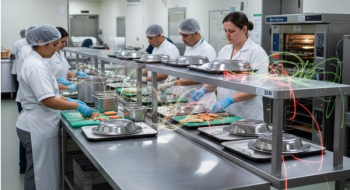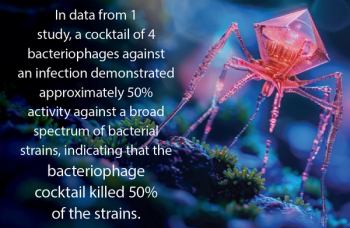
- Infection Control Today, May 2022, (Vol. 26, No. 4)
- Volume 26
- Issue 4
Surface Disinfection Incompatibility Does Not Support Effective Cleaning and Disinfection
The surface material and product damage caused by new advances in disinfection technology must be addressed for patient safety.
Cleaning and disinfection are critical and will always be an essential focus as health care professionals work to mitigate the spread of health care–acquired infections (HAIs). Yet, as new advances in disinfectants and disinfection technology continue to emerge, an overlooked issue continues to intensify and must be addressed.
Surface material and product damage caused by surface disinfection incompatibility impedes effective cleaning and disinfection, costs health care facilities millions of dollars annually, and creates dangerous safety issues for patients and health care personnel. There are many different materials and textiles within a health care facility, and they cannot all be cleaned and disinfected the same way. When they are, damage occurs. First, at a microscopic level, and then it continues until the damage is clearly visible.
It is impossible to deal with a microbial issue at a macro level. We all know microbes can’t be seen. Visual inspections following disinfection do not provide information about what remains on and in surfaces at a microbial level. Surface damage caused by incompatible disinfection methods—cracks, fissures, and pits—provides microscopic reservoirs for microbial attachments, colonization, and biofilm formation. This provides pathogens a potential safe harbor away from the biocides used to disinfect the surfaces, placing patients and health care personnel at risk for contracting infections.
Microbial Attachment
Many factors influence microbial attachment. It is critical to have a basic understanding of what can remain on surfaces after cleaning and disinfection. Well-documented research provides insight into the role surfaces play in acquiring and transmitting microbes that cause deadly infections. In a February 2021
Surface damage can support microbial attachment, colonization, and ultimately, biofilm formation. Biofilm is a complex matrix of extracellular polymeric substances that protect against environmental adversities. Once biofilm is formed, killing the bacteria or removing the biofilm that protects them is extremely difficult, as is disinfecting damaged surfaces where microbial reservoirs have been created. The selection of surfaces that are compatible with disinfectants used in the health care setting is critical during the design of products or the built environment.
A Case Study on Surface Disinfection Incompatibility
Because of the complexity of this problem, many facilities pay high costs for repair, replacement, and ongoing maintenance for medical equipment. In many cases, the cause of the problem is overlooked. In a jointly released case study,2 the Healthcare Surfaces Institute (HSI) and the Association of Healthcare Value Analysis Professionals conducted a deep-dive analysis to understand the root cause of damage to a medical device.
Discovering the Damage
A large midwestern hospital, with approximately 700 licensed beds and over 1.2 million patient encounters yearly, purchased several hundred state-of-the-art, noninvasive optical sensor medical device monitoring systems. There was visible damage to the monitoring systems within 2 years because of chemical exposure during the disinfection process. Such damage is susceptible to unreachable microbial reservoirs that inhibit disinfection, creating severe liability and costs for the hospital and manufacturer.
The Challenges and Gaps That Were Identified
The medical device company identified a lack of understanding and discussion about infection prevention products and guidelines used within the hospital. Although the medical device company met with many key decision makers, there was no central point of contact for them to work through, resulting in a breakdown of communication and the lack of involvement of critical experts during the evaluation process. Also, health care experts were excluded from initial meetings before the damage occurred; had they been consulted, it is possible some issues could have been avoided.
The case study also provided a clear example of the lack of guidelines and testing requirements for surface materials and products. When the medical device company applied for US Food and Drug Administration (FDA) 510(k) clearance, which is a process that evaluates a device’s safety against comparable legally marketed devices, they had testing done for surface disinfection and compatibility. The company was left to determine which cleaning agents to recommend for testing. Only 1 disinfectant was tested. The case study found that the hospital’s infection prevention and control guidelines did not support the use of the only disinfection method prescribed by the medical device manufacturer. The hospital was left to find an alternative for disinfection after purchasing the devices.
The fact that there are no guidelines or minimum testing requirements to validate surface disinfection compatibility is a problem. Minimum testing should require all categories of US Environmental Protection Agency (EPA)-registered hospital-grade disinfectants. There are hundreds of proprietary disinfectant products on the market in addition to no-touch technologies, and it would be cost prohibitive to test all disinfectants. However, by testing the categories of disinfectants, foundational information can be gained. Going beyond the minimum testing and working with the disinfectant companies from which hospitals purchase products will be essential.
Also discovered during this investigation were conflicting instructions for use (IFU) and care and maintenance manuals. The IFU provided information for the possible use of 2 other disinfectants. However, in small print was a warning against the use of the alternative disinfectant selected by the hospital, as there was concern that it may cause corrosion. Unfortunately, the small print was not noticed until the damage had occurred.
It was also determined that not all health care personnel were trained for cleaning and disinfection, such as their nursing staff disinfecting part of the device during patient care. They did not have access to the information they needed and were not offered the basic training.
Materials were not tested or evaluated for cleanability during the surface material selection process and before product development. It is currently not common for raw material manufacturers to test their materials for surface disinfection compatibility before selling them to manufacturers, which is missing a vital step. Product designers must have this information to support that the product’s design can be cleaned and disinfected without damage.
Collaboration Is Key
It was noted that medical suppliers benefit from having coordinated access to clinical staff for feedback on successes and potential device improvements. It is important to include critical information about the cleaning and disinfecting agents and processes used within the hospital. The information gained will support the manufacturer as they identify disinfectants for testing.
Before purchasing the monitoring device, the hospital’s evaluation and selection process would have benefited from active participation from a diverse group of health care professionals responsible for infection prevention, including environmental service, infection prevention, biomedical, nursing, and clinical professionals. All these professionals evaluate products differently, and the combined knowledge and discussion provides valuable insight into potential challenges and successes.
Medical Device Recalls
In the past 6 months, several medical device manufacturers faced FDA recalls for surface disinfectant incompatibility issues that caused risk to patients. Each of the recalls resulted in a requirement to do additional testing for surface disinfection compatibility and the rewriting of IFUs. Recalls are costly and could be avoided if guidelines and minimum testing recommendations were identified and followed.
Facilitate Change
Infection preventionists can help drive more awareness about surface disinfection compatibility. We can start with collaboration with health care personnel, biomed, raw material suppliers, device manufacturers and designers, and disinfectant manufacturers. We can bring together all the different groups working on surfaces to help health care facilities understand the importance of surface disinfection compatibility, surface disinfectant testing, IFUs, and how they are all tied together. We must work together to achieve the following:
- Develop a minimum standard for surface disinfectant compatibility that tests categories of disinfectants instead of proprietary products. If categories of disinfectant chemistries are tested rather than specific brand names, this helps simplify and clarify IFUs. This allows health care facilities to determine whether the products they already use are compatible with their equipment and medical devices. HSI has developed minimum testing standards, using 7 categories of EPA-registered, hospital-grade disinfectants. By bringing this issue to the forefront and addressing the issue at a microbial level, we will begin to see sustainable solutions to mitigate the spread of HAIs.
- Designate a single point of contact within a health care organization to facilitate collaboration between manufacturers and health care professionals and to communicate important matters to all parties. Health care facilities and systems have equipment and medical devices that are damaged or placed out of service for reasons not always known to staff. Having 1 “point person” to report equipment and device issues to, such as damage from cleaning products, would be invaluable.
- Establish a greater understanding of real-life challenges health care professionals face when working to mitigate the spread of infections within the health care setting. Medical device designers and manufacturers and disinfectant manufacturers do their best to create products that help keep patients and staff safe. However, sometimes there is a disconnect between the users and the vision research and development had in mind. A product with multiple nooks and crannies—although helpful in the design and build of a device—can pose a nightmare for cleaning and disinfection.
- Build awareness around the selection of surface materials during the design phase by medical device manufacturers based on surface disinfection compatibility. Raw materials must meet minimum standard requirements. The number of different types of medical devices and equipment is overwhelming. When you consider all the possible surface material components, such as plastics, metals, and coatings, it’s not hard to see how easily surface disinfection incompatibility can happen.
- Create guidelines for product reviews before purchase, as well as checklists for health care selection teams within the health care setting that provide essential information for product value analysis professionals. Infection preventionists already have guidelines or checklists to help evaluate disinfectants. They also need tools for assessing surface disinfection compatibility to determine whether a surface material or product can be safely cleaned and disinfected without causing damage that can harbor and transmit dangerous pathogens.
- Medical device suppliers should provide maintenance training, including a review of cleaning and disinfection for all users of their equipment or devices.
The lack of attention paid to surface disinfection compatibility with patient care equipment and devices results in damage, failure, and recalls of expensive—and sometimes critical—patient care equipment. Addressing the issue of surface disinfection compatibility can help prevent these financial losses. However, understanding how critical the issue of surface disinfection compatibility is to protect patients and keep health care personnel safe when handling patient care equipment and devices is more important. Infection preventionists can help drive the change needed to address surface disinfection compatibility in health care.
References
- Zheng S, Bawazir M, Dhall A, et al. Implication of surface properties, bacterial motility, and hydrodynamic conditions on bacterial surface sensing and their initial adhesion. Front Bioeng Biotechnol. 2021;9:643722. doi:10.3389/fbioe.2021.643722
- Surface disinfection incompatibility with medical devices creates potential patient risks. Healthcare Surfaces Institute. September 2021. Accessed March 11, 2022. https://www.healthcaresurfacesinstitute.org/case-studies/surface-disinfection-incompatibility-with-medical-devices-creates-potential-patient-risks/
Articles in this issue
over 3 years ago
Environmental Measures Disrupt Transmission of HAIsover 3 years ago
Getting Managerial Buy-In for Infection Control EffortsNewsletter
Stay prepared and protected with Infection Control Today's newsletter, delivering essential updates, best practices, and expert insights for infection preventionists.






